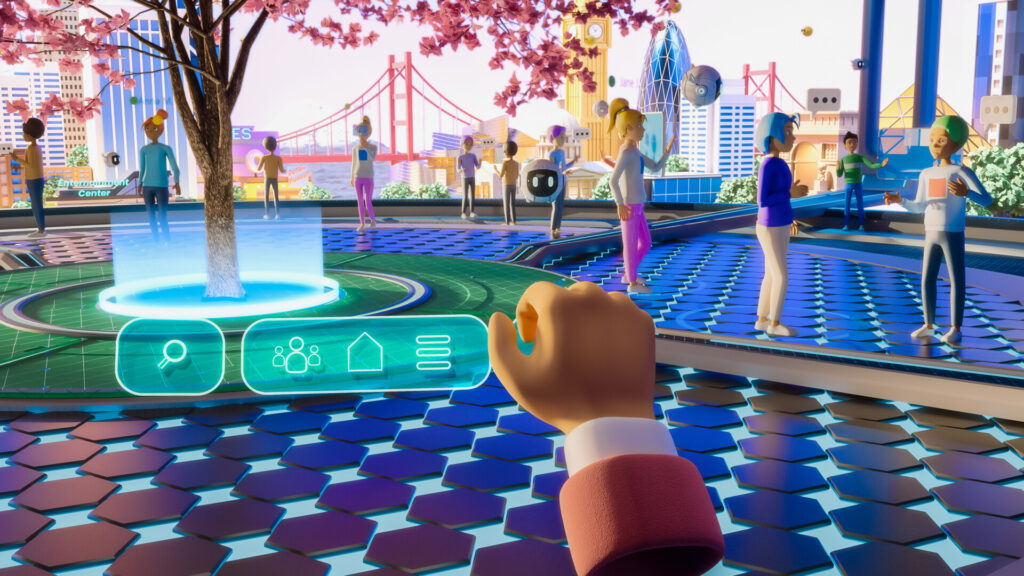


Already in our lives.
ㆍThe metaverse has been used in work, education, fashion, manufacturing, gaming, and more. There is a misconception that it is less prevalent than before.
ㆍBut today we’re going to talk about the “social impact” of the metaverse.
ㆍDiscover solutions to global problems and make positive contributions to the community using metaverse technologies.

Maybe even before that
The metaverse did not just appear out of nowhere. It is a combination of various existing technologies, such as the internet, networks, and artificial intelligence, which have been around for a long time. Recent advancements like VR, AR, blockchain, and 5G have accelerated innovation in the metaverse. The term “metaverse” was first mentioned in 1992. In his novel “Snow Crash,” novelist Neal Stephenson defined the metaverse as “a 3D virtual world in which people interact with programmed avatars.” Today, the term refers to social networking and economic activity in a digital virtual space. You can make friends in a metaverse community, play games, and accumulate assets. The metaverse is our world and our life.
| *Why did the metaverse become possible? The metaverse is influenced by Web 3.0, which refers to an environment where individuals can own their own data and trust is built between users through decentralized technologies like blockchain. In this environment, individuals and organizations can transact directly without relying on platforms, and the web is open, fair, and user-centric. Other names for this environment include the ownership economy, crypto-economy, and decentralized economy. The metaverse and Web3.0 share a philosophy of the digital world. The metaverse provides personalized, immersive virtual spaces and services for interacting and transacting in the digital world. If Web 3.0 technologies provide a secure and transparent way to transact and provide services, then the metaverse forms a new ecosystem. |
Save a life
It’s difficult to dismiss the metaverse as just a passing trend, especially considering its deep integration into our lives. Beyond simply using the metaverse for virtual business meetings or simulating product production, it has the potential to address real-world issues. For example, Smobler studio, a startup from Singapore, aims to leverage virtual space for social contribution projects.
ㆍNFT Art Auctions
Smobler collaborated with the Food Bank of Singapore (FBSG) to auction off artwork created by the company’s artists as NFTs. The aim was to raise funds for 10,000 beneficiaries in order to address food insecurity and alleviate food shortages in Singapore. The organization auctioned non-fungible tokens and accepted cryptocurrency donations to support this cause.
ㆍMetaverse Campus
Metaverse campuses are being established across Southeast Asia to offer affordable education opportunities. Smobler is teaming up with Aventis Graduate School to launch The Sandbox Academy, which aims to cultivate talent and creators for the open metaverse. The academy provides technical courses such as Voxel Art and Game Maker Certification and seeks to connect students with future job opportunities within the open metaverse.
ㆍEducation on the climate crisis
To this end, Smobler has developed a metaverse game called “3VEREST.” In this game, players can explore the Himalayas, make new friends, learn about the region’s history, and gain awareness of the impact of global warming. The game operates on the Ethereum blockchain, allowing users to own and trade digital avatars securely and in a decentralized manner. With its vivid landscapes and immersive universe, the game offers users a breathtaking educational adventure.

Building worlds together
Remember this slogan. Smobler studio is based in Singapore, with offices in Asia, North America, Latin America, and Europe. They are creating “Smobler worlds” worldwide. The new platform, the metaverse, enables people to connect and interact without the constraints of space and time. In the metaverse, seniors can become 3D avatars to access dementia education at virtual senior centers, connect with friends globally, and alleviate loneliness. Individuals unable to work due to physical limitations or in need of extra income may find opportunities in the metaverse. This means that while your physical body may be at work, your virtual avatar, representing “you,” can engage in other activities simultaneously. If this becomes the norm, it could potentially help address collective issues such as aging and income disparity. Can the metaverse save humanity? Let’s build a new continent together.

